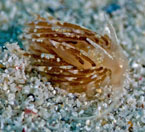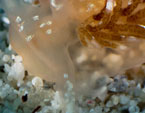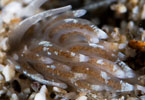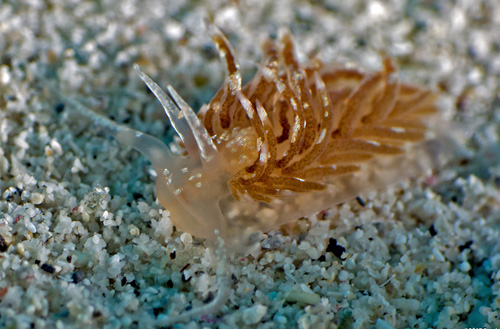| Home |
| Acknowledgments |
| Conventions |
| Glossary |
| Maps |
| References |
| Links |
| Articles |
| Thumbnails |
| Species
list |
| Family |
| Next
species |
Additional Photos

side

front

foot corner

cerata

pair, digging

Unidentified Facelinid sp. #7

| Maximum size: 5-6 mm. Identification: This species has a translucent-cream body with slender cerata, long rhinophores and long cephalic tentacles. The foot corners appear to be short and acute but attached to the remainder of the foot by a thin membrane. The ceratal cores are golden-brown and there are scattered iridescent-white patches on the cerata and body. Iridescent-white pigment is also concentrated on the upper surfaces of the rhinophores and cephalic tentacles. Cnidosacs appear to be present. It bears some similarity to Godiva sp. #1 but lacks the blue pigment of that species. Also, its cerata don't appear to be arranged in well-defined clusters. Natural history: Unidentified facelinid sp. #7 is known from four animals found crawling, by day, on open sand at a depth of 8-12 m (27-40 ft). It buries itself in the sand, if disturbed (or, when seeking food?). (Note 1) Distribution: Big Island and Kauai. Taxonomic notes: At first glance, it bears some similarity to Godiva but the genus remains uncertain pending further material (the family remains uncertain, as well...). It was first recorded in Hawaii off Kua Bay, Big Island by Celeste Spangler on June 3, 2017. Photo: Randall Spangler: 5-6 mm: found by Celeste Spangler; off Kua Bay, Big Island; June 3, 2017. Observations and comments: Note 1: Marketa Murray reported that her pair buried themselves, reemerged, then buried themselves again while observed. Perhaps, this is a variable response to disturbance/threat. Or, maybe excavating for buried food (retracted hydroids?). |
| Thumbnails |
Species
list |
Family | Next species | Top |